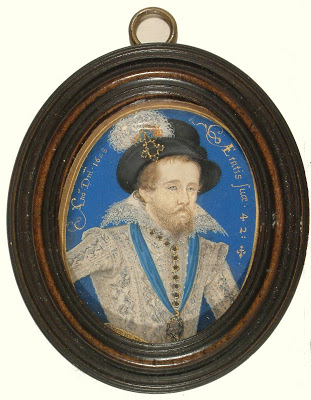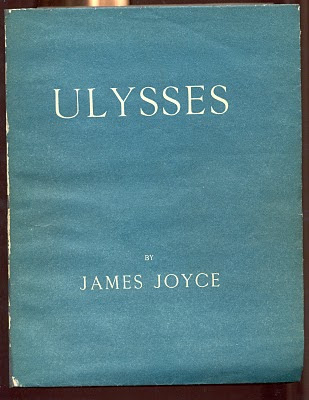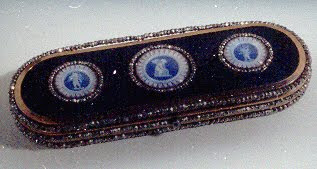First off is this lovely blue box, which dates from the late eighteenth-century (ca 1790-1800). The picture doesn’t do it justice, but the top and bottom are covered with a beautiful deep blue glass and the top contains three blue and white ceramic medallions. The box has a mirror on the interior of the the lid, which indicates that it may have been a patch box, used to hold the fake beauty marks which were fashionable at the time. Nicholas Hilliard. portrait of James I. 1609. 1954.1611
Nicholas Hilliard. portrait of James I. 1609. 1954.1611
Another wonderful blue item is this portrait of James I, by Nicholas Hilliard. Loyal readers may recall that I wrote about the loan of this object to an exhibit at Yale back in October. Trained as a goldsmith and jeweller, Hilliard became the court miniaturist to Elizabeth I and James I. His earlier experience with finely detailed jewels and precious metals stood him in good stead to depict the luxurious fabrics, metals and gems of his sitters. According the inscription flanking James’s head, this portrait was done “Ano Dni: 1608 / AEtatis Suae 42” (In the year of our Lord 1608 at the age of 42). You can see other examples of Hilliard’s portraiture in Britain’s Royal Collection. Dessert plate. ca. 1830. 1954.2015.43
Dessert plate. ca. 1830. 1954.2015.43
I’m also a big fan of the blue and gold dessert service which belonged to belonged to Benjamin Gratz’s second wife, Anna Boswell Shelby. Anna Maria Boswell was born in 1809 and in 1829 she married Orville Shelby, as his second wife. The dessert service, with its S initial, comes from this marriage. Orville died in 1835 and Anna married Benjamin Gratz in 1843. The dessert service is a great example of Empire or Late-Neoclassical design and features a very characteristic band of gold anthemion–a Greek-inspired palm frond motif–which I always think look like squids carrying pineapples.
 James Joyce (1882-1941), Ulysses. Paris: Shakespeare & Company, 1922. EL4 J89U1 922a Finally, I would be remiss not to show the first edition of Ulysses, with its beautiful blue wrappers. Sylvia Beach, owner of Shakespeare and Company, which published the book, described the trouble this blue cover caused: Joyce’s natural desire to have his book dressed in the Greek blue was one of worst difficulties.Who would have dreamed that the lovely blue of the Greek flag was not to be found? Again and again Darantiere [the printer] came up to Paris and we matched blues, only to discover that the new sample didn’t go with the Greek flag, which was kept flying at Shakespeare and Company in honor of Odysseus. Alas! merely to look at that flag gave me a headache. Darantiere’s search took him to Germany, where it ended with the discovery of the right blue–but this time it was the wrong paper. He solved this problem by getting the color lithographed on white cardboard, which explains why the insides of the covers were white.And I thought picking gallery colors was tough! OK, that’s it until next week, when I will be able to report on “something new,” the opening of our new exhibit, Westward Ho!.
James Joyce (1882-1941), Ulysses. Paris: Shakespeare & Company, 1922. EL4 J89U1 922a Finally, I would be remiss not to show the first edition of Ulysses, with its beautiful blue wrappers. Sylvia Beach, owner of Shakespeare and Company, which published the book, described the trouble this blue cover caused: Joyce’s natural desire to have his book dressed in the Greek blue was one of worst difficulties.Who would have dreamed that the lovely blue of the Greek flag was not to be found? Again and again Darantiere [the printer] came up to Paris and we matched blues, only to discover that the new sample didn’t go with the Greek flag, which was kept flying at Shakespeare and Company in honor of Odysseus. Alas! merely to look at that flag gave me a headache. Darantiere’s search took him to Germany, where it ended with the discovery of the right blue–but this time it was the wrong paper. He solved this problem by getting the color lithographed on white cardboard, which explains why the insides of the covers were white.And I thought picking gallery colors was tough! OK, that’s it until next week, when I will be able to report on “something new,” the opening of our new exhibit, Westward Ho!.

